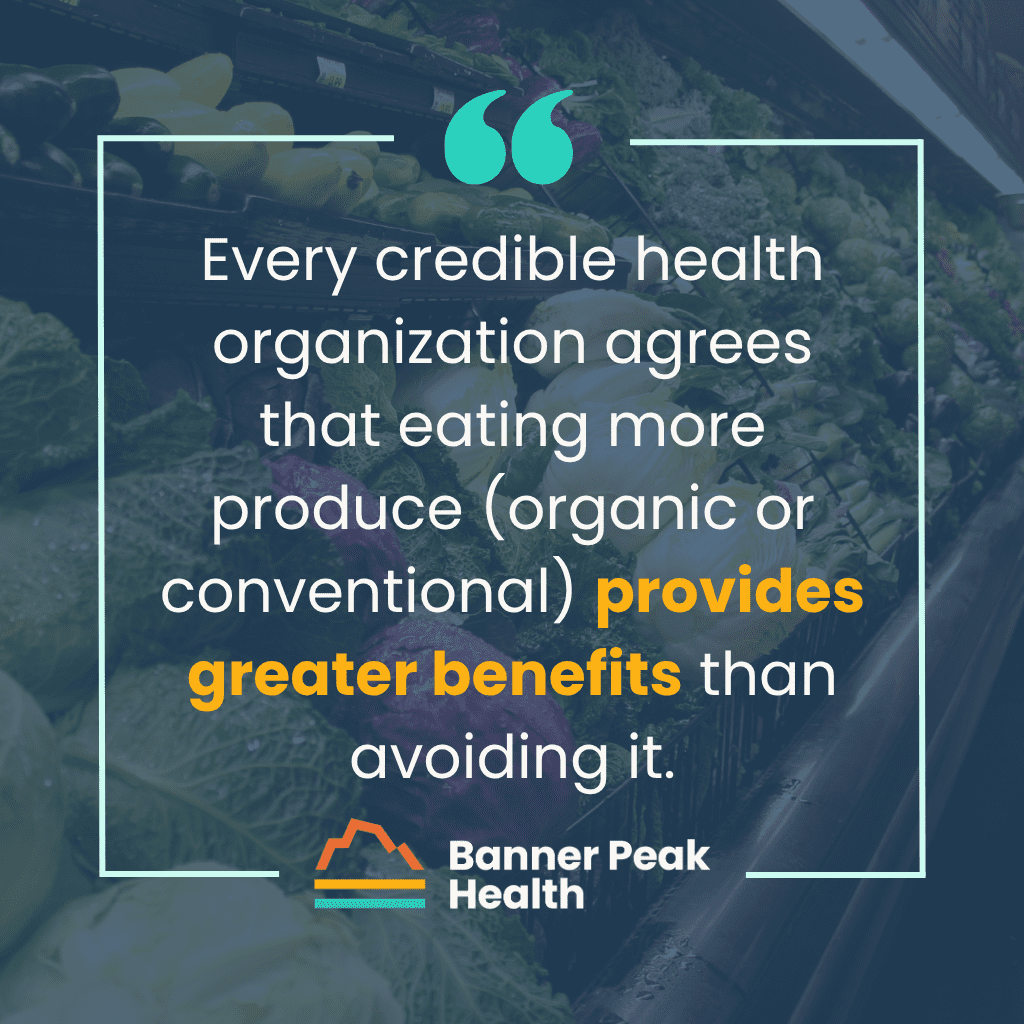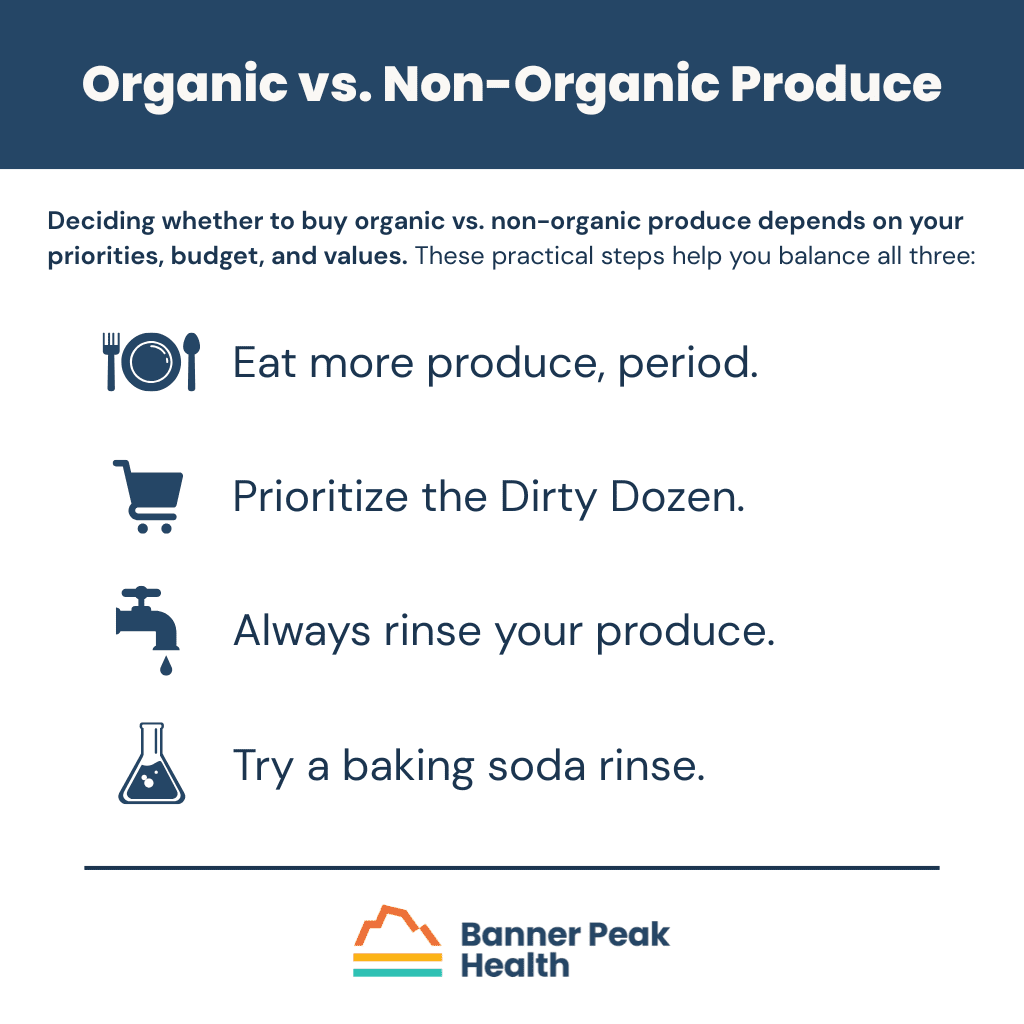You’re standing in the produce aisle, staring at two bundles of spinach. One has a USDA organic label and costs $5.99. The other is $2.99. You reach for the organic option, hesitate, then wonder: Is organic really better?
This question plagues health-conscious shoppers every week. Understanding what separates organic from conventional farming helps you make important decisions about your health, budget, and values.
What Is the Difference Between Organic and Non-Organic?
The difference between organic and non-organic produce starts with how food is grown.
When you see a USDA organic seal on produce, it means that food was produced according to strict federal regulations. These standards prohibit the use of synthetic pesticides, herbicides, fertilizers, genetically modified organisms, sewage sludge, and ionizing radiation, among others.
Organic doesn’t mean zero pesticide use. Organic farmers can use non-synthetic, plant-derived compounds to protect their crops. You’ll find products like neem oil (available over the counter for home gardeners), copper compounds, and sulfur. These natural substances help fight pests and disease.
USDA-certified organic farms must implement environmentally friendly practices, such as crop rotation, composting, and biological pest control. State-dependent organizations conduct farm inspections and testing to verify compliance with these standards.
For a product to carry the organic label, at least 95% of its ingredients must meet organic certification standards. Products labeled “100% organic” contain only certified organic ingredients.
Conventional farming takes the opposite approach, prioritizing yield and efficiency over soil integrity and environmental impact. These farms use synthetic fertilizers, herbicides, insecticides, and fungicides to make their crops resistant to diseases and drought.
Organic vs. Non-Organic Foods: Nutritional Differences
So, does organic produce contain more vitamins and minerals? The research presents a surprising finding: there’s only a minimal difference.
Several studies have shown that certain organic fruits may have higher antioxidant content and lower nitrate levels. When you examine the complete body of research on organic vs. non-organic foods, though, no substantial nutritional differences emerge. You can’t reasonably choose specific products based on superior nutrient density.
The real benefit of organic produce lies elsewhere: reduced exposure to synthetic pesticides.
Conventional produce contains higher levels of pesticide residue, although all levels fall within the Environmental Protection Agency’s safety limits. The EPA regulates the quantities of pesticides to keep consumers safe.
In 2025, a European analysis detected pesticide residue on 85.7% of conventional produce samples versus 40% of organic samples. Multiple meta-analyses confirm that pesticide residue appears about four times more frequently on conventional crops than on organic crops.
Regulations vary by region. More than 80 pesticides banned in the European Union remain approved for use in the United States. European countries tend to implement stricter food safety standards earlier than American agencies, a pattern that extends into pharmaceutical approval.
Health Implications of Pesticide Residue
The EPA maintains that pesticide exposure from conventional produce poses no health risk at typical consumption levels.
Limiting your fruit and vegetable intake because of pesticide concerns is a mistake. Every credible health organization agrees that eating more produce (organic or conventional) provides greater benefits than avoiding it.
The challenge lies in studying pesticide effects on humans.
Most pesticides function as endocrine-disrupting chemicals (EDCs). These compounds mimic or block natural hormones like estrogen, androgens, and thyroid hormones. EDCs can also inhibit enzymes your body uses to produce hormones. The result: potential disruption of both hormone production and your body’s response to hormonal signals.
Researchers have identified several possible health effects.
- Pesticide exposure may impact fertility, though no definitive link exists. If you’re struggling to conceive, reducing your pesticide exposure might be worth considering.
- Some evidence suggests that pesticide exposure during pregnancy may affect fetal neurodevelopment by disrupting hormone signaling.
- Studies have explored potential links to hypothyroidism, though the data remains inconclusive.
- Pesticide exposure may be linked to Parkinson’s disease, according to some studies.
Glyphosate is a herbicide that appears in many conventional crops, particularly oats. You’ll often see organic oats labeled “glyphosate-free.” The World Health Organization classifies glyphosate as a probable human carcinogen based on epidemiological associations with non-Hodgkin’s lymphoma. The U.S. EPA disagrees, stating glyphosate is unlikely to be carcinogenic at real-world exposure levels.
Another pesticide, chlorpyrifos, showed stronger evidence of harm. Epidemiological studies identified adverse neurodevelopmental outcomes in children exposed during pregnancy, with a dose-response relationship. Higher exposure during the first and third trimesters led to a greater likelihood of neurodevelopmental problems.
Chlorpyrifos was banned in the EU in 2020, and in 2021, the EPA effectively banned its use on food and feed crops in the U.S. Two years later, the U.S. Court of Appeals for the Eighth Circuit overturned that ban and sent the matter back to the EPA for further proceedings. As of this writing, the EPA is re-evaluating chlorpyrifos regulations.
Studies examining long-term health associations face a limitation: people who consume organic produce tend to be healthier overall. These individuals make other health-conscious choices, creating unavoidable bias in observational data. Associations between organic food consumption and lower rates of obesity, hypertension, and metabolic disease don’t prove causation.
No randomized controlled trials or meta-analyses have shown long-term health benefits from organic produce. The primary proven advantage is reduced pesticide exposure. The nutritional benefits of consuming produce far outweigh the potential risks associated with pesticides.
Environmental Impact: Beyond Personal Health
Your food choices affect more than your body. Organic and conventional farming have vastly different environmental footprints.
Organic farming yields healthier soil, characterized by increased organic matter and enhanced microbial diversity, which in turn improves long-term soil fertility and water retention. Reduced synthetic pesticide use means more insects, pollinators, and beneficial soil organisms thrive. These elements create a natural, healthy soil environment that produces better crops over time.
Conventional fertilizers and pesticides create another problem: runoff. Heavy rain can wash these chemicals into local water sources, contaminating rivers, lakes, and groundwater. This affects the aquatic organisms and animals that rely on these water sources.
Water treatment facilities remove most contaminants before human consumption, but runoff remains an environmental concern.
Strategic Shopping: The Dirty Dozen and Clean Fifteen
Cost is most families’ biggest barrier to buying organic. You don’t need to purchase all organic produce to reduce your pesticide exposure. Strategic choices make the biggest difference.
The Environmental Working Group (EWG), a nonprofit organization, helps consumers make better decisions. The EWG analyzes data the USDA collects on pesticide residue in produce.
The USDA’s testing methodology is interesting: instead of testing produce straight from the farm, testers wash and prepare samples as consumers would at home, which reflects real-world pesticide exposure. They rinse produce under running water for 15 to 20 seconds. If the item requires peeling, they peel it.
The EWG ranks produce based on four variables:
- Abundance: The percentage of samples with at least one detected pesticide
- Diversity: The average number of different pesticides on a single sample
- Intensity: The concentration of pesticides
- Toxicity: Estimated toxicity based on pesticide concentration
This analysis produces two lists: the Dirty Dozen (highest pesticide residue) and the Clean Fifteen (lowest pesticide residue).
The Dirty Dozen includes produce with higher pesticide levels: spinach, grapes, blackberries, blueberries, and strawberries. Berries consistently rank high for pesticide residue.
The Clean Fifteen features items with thicker peels or protective layers: pineapple, corn, avocado, onions, and watermelon. You remove these protective layers before eating, so you don’t need to invest extra money in organic versions.
Here’s an example: Most grocery stores stock both organic and conventional bananas. Bananas have thick peels that you remove before eating, so you’re probably fine choosing conventional bananas. The price difference is minimal, but the pesticide exposure difference is negligible.
Today’s Takeaways
Deciding whether to buy organic vs. non-organic produce depends on your priorities, budget, and values. These practical steps help you balance all three:
Eat more produce, period. Don’t limit your fruit and vegetable intake over pesticide concerns. The nutritional benefits outweigh potential risks.
Prioritize the Dirty Dozen. If you want to reduce pesticide exposure, focus your organic purchases on the produce ranked highest for pesticide residue. This provides the most value for your money.
Always rinse your produce. The USDA’s pesticide data comes from washed produce. At a minimum, rinse all produce (organic or conventional) for 20 to 30 seconds under running water.
Try a baking soda rinse. Research shows soaking produce in a baking soda solution removes a large percentage of surface pesticides. A 2017 study found that soaking apples for 12 to 15 minutes in baking soda water removed substantial amounts of surface contaminants (though pesticides that penetrate deeper into the peel remained). Peeling produce eliminates more pesticides but also removes beneficial vitamins, minerals, and fiber.
In my house, we buy organic for the items on the Dirty Dozen list. When organic isn’t available, we use a baking soda rinse. The process is simple: mix about half a cup of baking soda with water, soak your produce for 12 to 15 minutes, then rinse thoroughly.
We don’t measure precisely or create exact percentages. The goal is practical protection, not laboratory precision.
So, is organic really better? The answer depends on what “better” means to you. Organic produce exposes you to fewer synthetic pesticides and supports more sustainable farming practices. It doesn’t provide dramatically superior nutrition. Whether that trade-off justifies the higher cost is up to you.
Make informed choices based on your circumstances, and remember that any produce is better than no produce.

Ari Katz, MD
Dr. Katz has dedicated himself to preventative medicine and building meaningful patient relationships. He joined Banner Peak Health as a concierge physician to provide the personalized, comprehensive care that allows him to focus on his four pillars of wellness and help patients achieve their optimal health.





